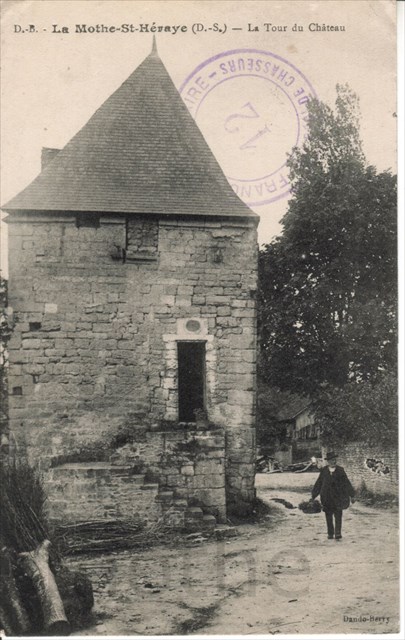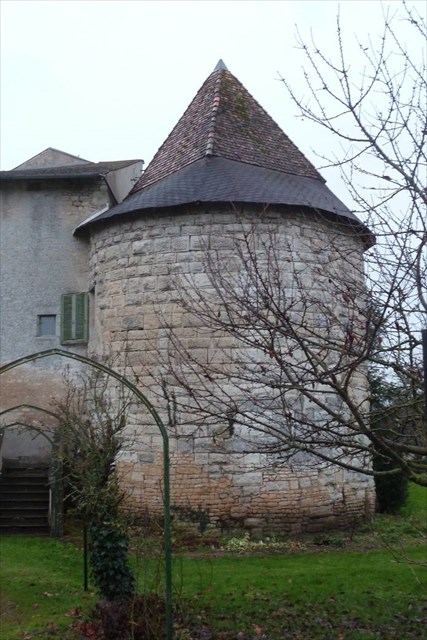Français :
Marie arrive par derrière le château. Elle aperçoit un chat sur la pelouse.
- Monsieur le chat, je m'appelle Marie et je cherche la Rosière. L'avez-vous vue ?
- Foi de Chat Botté, il y a belle lurette qu'il n'y a plus personne ici. Monte plutôt dans les jardins suspendus, de là tu verras tout le village. Peut-être l'apercevras-tu.
Il ne reste plus trace aujourd'hui de l'ancien château de la Mothe, hormis l'orangerie et des communs, dont trois tours. La tour de la glacière est la tour ronde qui se trouve en face de vous.
 La tour carrée au début du XXème
La tour carrée au début du XXème
La première mention du château date de 1041 ; il s'agissait probablement d'une motte féodale. Au milieu du XIVe siècle, un château fort en pierre est attesté. Il est entouré de douves et précédé au nord-ouest d'une vaste basse-cour fermée sur trois côtés par des communs importants pouvant loger une garnison. Quelques vestiges défensifs, archères, sont encore visibles sur les élévations extérieures des communs, qui étaient ceints de larges fossés remplis d'eau. Au XVIIe siècle, la forteresse est transformée en logis, et l'orangerie est bâtie. Acheté en 1840 par un particulier, le château fut vendu pierre par pierre. De nombreuses sculptures ont été remployées dans les maisons du canton, une partie des communs a été conservée et transformée en plusieurs fermes.
 La tour de la Glacière
La tour de la Glacière
La tour que vous pouvez voir au bout de l'impasse est appelée la Tour de la Glacière. C'est là que les seigneurs stockaient la glace, à l'époque il n'y avait pas de réfrigérateur !
Apportez un crayon. L'indice à noter se trouve sous le couvercle du tube.
English:
Marie comes from behind the castle. She sees a cat on the lawn.
- Mr. Cat, my name is Mary and I seek the Rosiere. Have you seen her?
- On my word as Puss in Boots, it was ages ago that there is nobody here! Go up rather in the hanging gardens, where you will see the whole village. Perhaps you'll catch sight of her.
There remains no trace today of the old castle of la Mothe, except the orangery and service quarters, including three towers.
The first mention of the castle dates from 1041 and it was probably a motte. In the middle of the fourteenth century, a stone castle is certified to exists. It is surrounded by a moat and preceded northwest by a large courtyard, enclosed on three sides by big service quarters which can accommodate a garrison. Some defensive remains, like arrow slits, are still visible on the external elevations of the service quarters, which were girded by moats full of water. In the seventeenth century, the fortress was modified into a stately dwelling, and the orangery is built. Purchased in 1840 by an individual, the castle was sold piece by piece. Sculptures have been reused in the houses of the township, some of the service quarters has been preserved and converted into several farms.
The tower you can see at the end of the cul-de-sac is called the "Tour de la Glacière" (the Cooler Tower). This is where the lords were storing the ice at the time there was no fridge !
Bring a pencil. The hint is noted under the lid of the tube